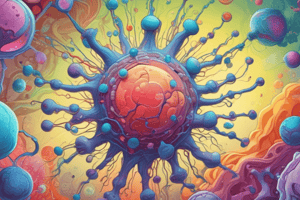Podcast
Questions and Answers
What is the primary function of pumps in active transport?
What is the primary function of pumps in active transport?
- To maintain homeostasis by separating molecules (correct)
- To break down ATP into ADP
- To move molecules from high to low concentration
- To synthesize ATP from Pi molecules
What is the net result of ATP breakdown into ADP?
What is the net result of ATP breakdown into ADP?
- Pi molecules are synthesized
- Energy is stored
- ADP is converted to ATP
- Energy is released (correct)
What is the primary function of the Na+/K+ pump in animal cells?
What is the primary function of the Na+/K+ pump in animal cells?
- To regulate pH levels
- To regulate the concentration of oxygen
- To regulate temperature
- To regulate the concentrations of Sodium and Potassium (correct)
What is the process of taking liquids or large molecules into the cell called?
What is the process of taking liquids or large molecules into the cell called?
What happens to the vesicle formed during endocytosis?
What happens to the vesicle formed during endocytosis?
What is the process of removing or secreting materials from the cell called?
What is the process of removing or secreting materials from the cell called?
ATP is formed when ADP is broken down into Pi.
ATP is formed when ADP is broken down into Pi.
The Na+/K+ pump is found in plant cells.
The Na+/K+ pump is found in plant cells.
Endocytosis is the process of removing materials from the cell.
Endocytosis is the process of removing materials from the cell.
Active transport requires energy from the food we eat.
Active transport requires energy from the food we eat.
Pumps in active transport move molecules from areas of high concentration to areas of low concentration.
Pumps in active transport move molecules from areas of high concentration to areas of low concentration.
Exocytosis is the process of taking liquids or large molecules into the cell.
Exocytosis is the process of taking liquids or large molecules into the cell.
Flashcards are hidden until you start studying



